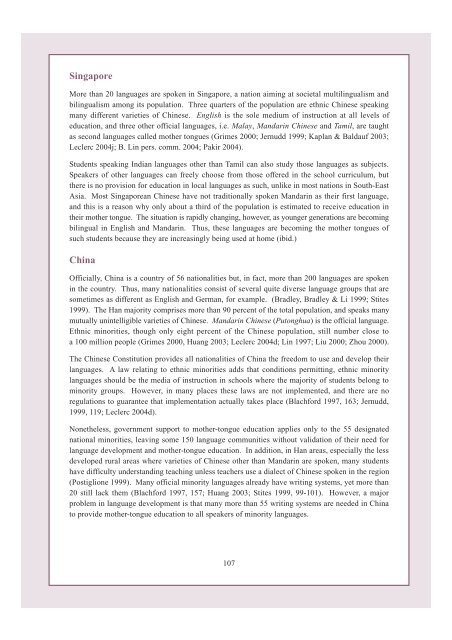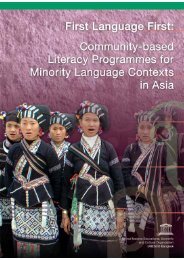Part II.pdf - MTB-MLE Network
Part II.pdf - MTB-MLE Network
Part II.pdf - MTB-MLE Network
Create successful ePaper yourself
Turn your PDF publications into a flip-book with our unique Google optimized e-Paper software.
Singapore<br />
More than 20 languages are spoken in Singapore, a nation aiming at societal multilingualism and<br />
bilingualism among its population. Three quarters of the population are ethnic Chinese speaking<br />
many different varieties of Chinese. English is the sole medium of instruction at all levels of<br />
education, and three other official languages, i.e. Malay, Mandarin Chinese and Tamil, are taught<br />
as second languages called mother tongues (Grimes 2000; Jernudd 1999; Kaplan & Baldauf 2003;<br />
Leclerc 2004j; B. Lin pers. comm. 2004; Pakir 2004).<br />
Students speaking Indian languages other than Tamil can also study those languages as subjects.<br />
Speakers of other languages can freely choose from those offered in the school curriculum, but<br />
there is no provision for education in local languages as such, unlike in most nations in South-East<br />
Asia. Most Singaporean Chinese have not traditionally spoken Mandarin as their first language,<br />
and this is a reason why only about a third of the population is estimated to receive education in<br />
their mother tongue. The situation is rapidly changing, however, as younger generations are becoming<br />
bilingual in English and Mandarin. Thus, these languages are becoming the mother tongues of<br />
such students because they are increasingly being used at home (ibid.)<br />
China<br />
Officially, China is a country of 56 nationalities but, in fact, more than 200 languages are spoken<br />
in the country. Thus, many nationalities consist of several quite diverse language groups that are<br />
sometimes as different as English and German, for example. (Bradley, Bradley & Li 1999; Stites<br />
1999). The Han majority comprises more than 90 percent of the total population, and speaks many<br />
mutually unintelligible varieties of Chinese. Mandarin Chinese (Putonghua) is the official language.<br />
Ethnic minorities, though only eight percent of the Chinese population, still number close to<br />
a 100 million people (Grimes 2000, Huang 2003; Leclerc 2004d; Lin 1997; Liu 2000; Zhou 2000).<br />
The Chinese Constitution provides all nationalities of China the freedom to use and develop their<br />
languages. A law relating to ethnic minorities adds that conditions permitting, ethnic minority<br />
languages should be the media of instruction in schools where the majority of students belong to<br />
minority groups. However, in many places these laws are not implemented, and there are no<br />
regulations to guarantee that implementation actually takes place (Blachford 1997, 163; Jernudd,<br />
1999, 119; Leclerc 2004d).<br />
Nonetheless, government support to mother-tongue education applies only to the 55 designated<br />
national minorities, leaving some 150 language communities without validation of their need for<br />
language development and mother-tongue education. In addition, in Han areas, especially the less<br />
developed rural areas where varieties of Chinese other than Mandarin are spoken, many students<br />
have difficulty understanding teaching unless teachers use a dialect of Chinese spoken in the region<br />
(Postiglione 1999). Many official minority languages already have writing systems, yet more than<br />
20 still lack them (Blachford 1997, 157; Huang 2003; Stites 1999, 99-101). However, a major<br />
problem in language development is that many more than 55 writing systems are needed in China<br />
to provide mother-tongue education to all speakers of minority languages.<br />
107
















